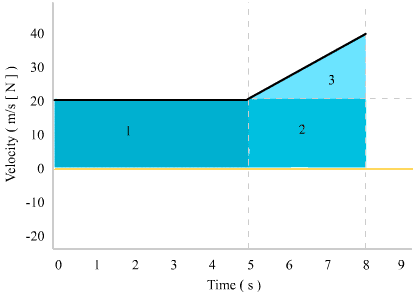Visualizing Motion
In this chapter we will see what the graphs of vector motion look like, as well as see how certain formulae are derived from the graphs.
Position V.S. Time

Since position is a vector quantity, position-time graphs contain a direction. Above, the positive position quantities are in the North direction while the negative quantities are in the opposite, South, direction. A position of zero signifies that the object is at the reference point, its starting position.
Analysis
- The object is changing its position in the north direction from 0 to 3 seconds, the velocity is uniform.
- The object stays at the same position for about 3 seconds - its stopped for 3 seconds.
- From the 6th to the 8th second the object is backtracking, its returning to the starting position ( our reference point ).
- From the 8th second on the object passes the starting position and travels southward from it.
The slope of the line on a position-time graph would be the velocity, because
position / time = velocity.
Velocity V.S. Time

Analysis
- Our data is captured when the object is already moving, it has a constant velocity of 30m/s [N] up to the 3rd second of observation.
- The object decelerates, reaches 0 velocity and then begins travelling in the south direction.
- The object travels at a constant velocity south for 3 seconds
- The object smoothly decelerates and comes to a stop
We can deduct interesting information from a velocity-time graph:
The slope of the line is the acceleration, but the area under the the line is the displacement!
Let's see how to determine the displacement an object undergoes during a given time:

Determining the displacement of the object in the first 5 ( area 1 ) seconds
is simple, the shape is a square and you multiply 20m/s times 5 seconds.
The displacement during those 5 seconds is 100m [N].
The displacement undergone by the object from 5 seconds to 8 seconds is a bit harder to determine, because the shape under the line is more complex. The area of the square ( area 2 ) is 20m/s times 3 seconds, and represents a displacement of 60m [N]. The are of the triangle ( area 3 ) is 20m/s ( 40 - 20 ) times 3 seconds, divided by two. Thus the area of the triangle ends up reperesenting a displacement of 30m [N].
We can deduct that during the 8 seconds of the object's motion it has undergone a displacement of 100 + 60 + 30 metres northward.
When the line falls blow the 0m/s mark the displacement is happening in the opposite direction. This "negative displacement" should be subtracted from the "positive displacement" to find out what is the resultant displacement and its direction.
Uniform Acceleration Equations

Several useful formulae are deductible from the velocity vs time graph of an object's motion. When an object undergoes uniform acceleration its graph looks like a trapezoid, above the object accelerated uniformly up to time t.
We can find out the acceleration of the object by finding the slope of the graph. Slope is rise over run:
M = ( Y2 - Y1 ) / ( X2 - X1 )
accleration = ( Vf - Vi ) / ( t - 0 )
a = ( Vf - Vi ) / t
We can model displacement mathematically by formulating a formula for the area of a trapezoid, but using Vf, Vi and t instead of lengths. The formula for a trapezoid is 1/2 ( Y1 + Y2 ) × W where W is the width of the base. Adapting the above formula we get the formula for displacement during uniform acceleration:
1/2 ( Vf + Vi ) × t
Acceleration V.S. Time


In this website only uniform acceleration is discussed. Uniform acceleration can be seen on the left, it occurs when the object accelerates at a constant rate. On the acceleration vs time graph of a uniformly accelerating object the acceleration will appear as a horizontal line.
On the right, however, is the acceleration vs time graph of an object with a varied acceleration. The acceleration apears as a sloped line, indicating that the acceleration is changing. The graph on the right shows an object decelerating, stopping acceleration ( uniform speed ) and then beginning to accelerate in the south direction.
Conclusion
The velocity vs time graph is arguably the most important one of all because the two most important Uniform Acceleration formulae can be deduced from it.
When a velocity vs time graph of an object's motion looks like a horizontal line the object's acceleration is zero, Vf = Vi and usually the most basic formulae for motion are used.